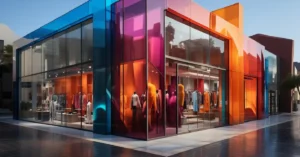Staying ahead in the retail industry demands innovative solutions. Prefabricated metal stores and malls have emerged as a specific and technically advanced approach to creating efficient retail spaces. This article explores the precise details of how these prefabricated manufactured buildings offer distinct benefits.
Advanced Material Selection
Prefabricated metal retail spaces leverage high-grade steel, renowned for its exceptional strength-to-weight ratio. This specific choice of material ensures that the structures can support heavy loads. This makes them ideal for accommodating large inventories, rooftop gardens, or solar panels without compromising structural integrity.
Modular Design
These retail spaces are designed with modularity in mind, allowing individual sections or modules to be easily added or removed. This specific flexibility enables retailers to adapt to changing needs, whether it’s expanding during a holiday season or downsizing to reduce operating costs.
Precision Engineering
Prefabricated metal structures are fabricated with precision using computer-aided design (CAD) and manufacturing (CAM) technologies. This level of specificity ensures that every component fits together seamlessly during assembly, reducing construction time and minimizing the risk of errors.
Integrated Technology
Retailers can benefit from the integration of specific technological features. Prefabricated metal stores and malls can incorporate advanced HVAC systems, lighting controls, and security systems that are optimized for energy efficiency and seamless operation. These specific technological enhancements contribute to a more comfortable and secure shopping environment.
Streamlined Permitting Process
Obtaining permits for traditional construction can be a time-consuming and bureaucratic process. Prefabricated metal structures often streamline this specific aspect, as they are manufactured to meet local building codes and regulations. This can significantly expedite the approval process, allowing retailers to open their doors sooner.
Weather Resistance
The use of metal in construction provides specific weather resistance benefits. Metal roofs are designed to withstand specific weather conditions, from heavy snow loads to intense rainfall. This specific durability ensures that the retail space remains operational even during adverse weather events, reducing potential downtime.
Growing and Adapting Your Store
These structures are great because they can change in size as your business gets bigger. You can begin with a smaller space and then make it larger over time as your business grows. This helps you use your resources wisely and adjust your store’s size as your business keeps getting better.
Seismic Performance
In regions prone to earthquakes, the seismic performance of structures is crucial. Prefabricated metal retail spaces can be engineered to specific seismic codes, ensuring the safety of customers and employees even in earthquake-prone areas. These structures incorporate advanced seismic design features such as reinforced steel frames and flexible connections, further enhancing their ability to withstand seismic forces and protect both people and merchandise. With such robust seismic resilience, retailers can operate with confidence in areas vulnerable to earthquake activity, safeguarding their investments and the well-being of those within their retail spaces.
High Energy Efficiency
Precise energy efficiency is essential for controlling operational costs. These retail spaces can be outfitted with specialized insulation, reflective roofing, and energy-efficient windows, reducing heating and cooling expenses. Specific solar panel installations can be seamlessly integrated into the design to harness renewable energy.
In summary, prefabricated manufactured buildings are a precise and technologically advanced solution for creating efficient retail spaces. With advanced material selection, modular design, precision engineering, etc., these structures offer retailers a competitive edge in the ever-evolving world of retail. By harnessing these specific benefits, retailers can optimize their operations, enhance customer experiences, and thrive in today’s competitive marketplace.
